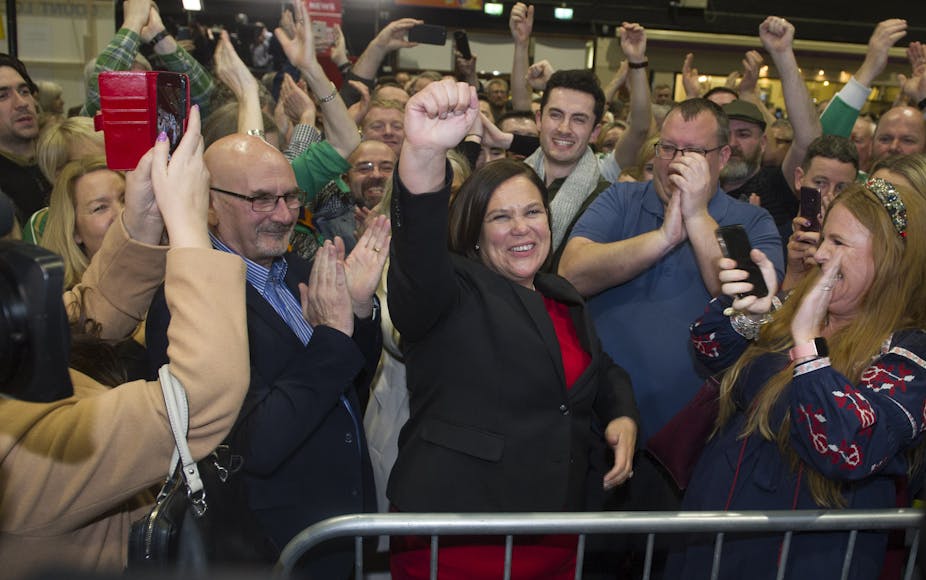Sinn Féin’s surge in popularity is the major story of the 2020 Irish general election. The left-wing, nationalist party won a mere 9.5% of the vote in 2019 local elections and, simultaneously, lost two of its three European Parliament seats. Yet in the February 8 general election Sinn Féin has won almost a quarter of the first preference votes (24.5%), ahead of leading rivals Fianna Fáil and Fine Gael, and has emerged as a viable governing party.
Even Leo Varadkar, the outgoing Taoiseach or prime minister who leads Fine Gael, failed to top the poll in his constituency. He received 4,000 fewer first-preference votes than the Sinn Féin candidate. Terms such as historic, unprecedented and seismic are being used to describe the result.
Historically, Ireland’s party system has been the “odd man out” in Western Europe. Dominated by two ideologically similar parties of the centre right, Fianna Fáil and Fine Gael, the country has, remarkably, never had a majority left-wing government. The centre left of the political spectrum was occupied by a small Labour Party, while Sinn Féin’s focus on the issue of a united Ireland and its associations with violence in Northern Ireland meant it failed to achieve representation in the Irish parliament between 1961 and 1997.
Election 2020 appears to have brought about significant change to this traditional arrangement. Under Ireland’s proportional single transferable vote electoral system, Sinn Féin has so far won the first seat in 24 of the country’s 39 multi-member districts.
An upswing in Sinn Féin’s fortunes
The election results were largely unexpected, not least by Sinn Féin itself, which appears to have mismanaged its campaign by running only one candidate in constituencies where it could have easily elected two MPs (TDs) under the Irish electoral system. Although, as recently as November, the party was running at just 11% cent in some opinion polls, so this caution was not unwarranted.
This volatility in Sinn Féin’s electoral support also suggests that talk of permanent and irreversible change to the Irish party system may be a little premature. It will take several more elections to confirm if these new Sinn Féin voters are loyal to the party.
An exit poll published on the night of the election indicated that the housing crisis and the state of the health system were the two main issues for voters, with almost 60% of the electorate listing one or other of these as the most important factor in their voting decision. Brexit, immigration, taxation and crime barely featured in voters’ decision calculus.
Fine Gael did not get a bounce from its successful representation of the country in the Brexit negotiations, with only 1% of voters listing this as the most important factor when it came to casting their ballot. Nor was Fine Gael rewarded for its management of the economy through the austerity years. Over the course of its nine year tenure in office, unemployment was reduced from over 15% to under 5% and Ireland experienced the highest GDP growth rates of any EU member state.
But this turnaround in economic fortunes was not spread evenly across society. According to the exit poll, 77% of Sinn Féin voters felt that they hadn’t personally benefited from the improvement in the economy in recent years. The cost of living, particularly housing, and a two-tier health system with the longest waiting lists in Europe were foremost in voters’ minds.

Sinn Féin also ran a highly professional and cohesive campaign with a message that was laser-focused on change. The party’s manifesto promised to increase public spending by €22 billion (£18.6 billion) over five years of government, while simultaneously cutting income and property taxes for large cohorts of the population. This message particularly resonated with the young, as almost a third of 18 to 24-year-olds gave their first preference to the party compared with only 12% of those over 65.
Ultimately, Fine Gael, after two terms in office, struggled to convince voters it could resolve the housing and health crisis. Meanwhile, many have not forgiven Fianna Fáil for its mismanagement of the country in the years leading up to the economic crash.
Government formation
With three relatively equal-sized parties in contention, some dual combination of Fianna Fáil, Fine Gael and Sinn Féin is mathematically the most realistic coalition outcome. But historic enmities and campaign rhetoric now make government formation far from straightforward. Over the course of the campaign, both Fianna Fáil and Fine Gael explicitly ruled out governing with Sinn Féin, and Fianna Fáil also ruled out a “grand coalition” with Fine Gael.
As vote counting continued across Ireland, Sinn Féin President Mary-Lou McDonald said she wanted to try and forge a left-wing governing coalition.
A second election is a real possibility, but in the short term this will likely only benefit Sinn Féin, which won’t make the mistake of running too few candidates a second time. A third option is a Fianna Fáil minority government, with Fine Gael returning the favour of the past four years by giving support in a confidence and supply arrangement. But given the likely final seat distribution it could be a very precarious arrangement, unless the Greens or Labour are also brought on board, which seems unlikely. All is to play for in the coming weeks.

